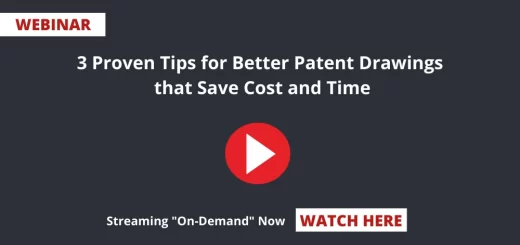Search Indian Patents Comprehensively – Webinar
Table of Contents
Key-points Covered in this Webinar (Search Indian Patents Comprehensively) Session
- Are IPCs on Indian patents correctly tagged?
- Can I trust the IPC based searches for comprehensively covering Indian Patents?
- Is assignee information reliable?
- The best method to conduct a search to capture relevant Indian patent. IPC only, IPC + keyword, Keyword only, etc?
- Which are the best databases to search Indian patent information comprehensively?
- Is legal status detail on various databases updated and comprehensive?
Key-note Speakers
Manish Sinha, Chief Technology Officer, Gridlogics
Ginish George, Director Operations, Relecura
Kavita Poddar, Senior IP Director, Questel Orbit
Rohit Joshi, Manager, Sagacious IP
Rajat Gulati, SBU Head, Sagacious IP
Moderated By
Tanmay Mittal, Head – IP Solutions – India Region, Sagacious IP
Submit Your Information to watch the Webinar Video:
"*" indicates required fields
More details about this Webinar
As the Indian economy is growing and more and more companies are targeting India for their business expansion, searching patents filed in India is becoming more and more crucial. However, to search Indian patents comprehensively is always a challenge. This webinar provides answers to some basic questions asked by patent searchers, globally, when searching for relevant Indian patents.
Webinar Transcript
Tanmay Mittal Speaking – Welcome everyone to the webinar, this is Tanmay Mittal, Head of IT Solutions, India region at Sagacious, signing in to welcome you all to our webinar today. In our endeavor to demystify IP information and contribute towards boosting IP awareness, Sagacious IP is happy to host today’s webinar, which will not only throw light on best practices to search Indian patents but also allow us to interact with industry leaders and learn from their experiences.
The topic for today’s webinar is Search Indian Patents Comprehensively and before I go on to introduce the esteemed speakers for today’s session, I’m delighted to welcome all the participants from different countries and thank them for taking out the time to join us today. As I always say, your participation is a wonderful encouragement to the efforts and attempt that we are making to raise awareness about the intellectual property through the knowledge that has been honed by Sagacious over several years of working with inventors, R&D organizations, IP departments, and IP law practices. Without further wait, let me introduce our speakers.
Introduction of the Speakers
Our first speaker is Rajat Gulati, Rajat is the Business Unit Head for Engineering searching team at Sagacious IP. Rajat carries an exhaustive experience of 15 years in the patent industry with IP expertise in patent research and analytics. Rajat carries with his technical expertise in mechanical automobile and manufacturing domains. Rajat also has prior experience in successfully setting up collaboration platforms to foster innovation and IP with R&D based firms and technical universities. Welcome to the webinar Rajat.
Rajat Gulati – Thank you, Tanmay, hello everyone.
Tanmay Mittal Speaking – I’m happy to introduce Rohit Joshi to the audience now. Rohit is managing a team of young dynamic and sharp engineers in the domain of mechanical engineering at Sagacious IP. Rohit carries an exhaustive experience of seven years and has a knack of searching patent information on several databases and Patent Office websites. In his previous experience, he has been associated with a lot of reputed Fortune 500s, helping them get FTO, invalidity, and novelty searches. Welcome to the webinar Rohit.
Rohit Joshi – Thank you, Tanmay for having me on the webinar.
Tanmay Mittal Speaking – Next, we have Kavita joining us for today’s session. Kavita Poddar is Senior IP Director at Questel India and carries an exhaustive 13-year experience in the industry. To our listeners, Questel delivers intellectual property solutions across the innovation life-cycle, their patent database orbit is well known in the IP community. Kavita has been associated with Questel for 12 years, and, thus, knows almost everything that is to know about Questel and orbit. Welcome to the webinar Kavita.
Kavita Poddar – Thank you for this conference, and for allowing me to talk on the Indian Patent database, I look forward to sharing my experience.
Tanmay Mittal Speaking – Thank you, Kavita, great to have you. Next, we have Doctor Ginish George, joining us today. Ginish is the Director of Operations at Relecura and brings 15 plus years of experience in IP research and digital product development. He began his career as an IP analyst and later started working on custom products, the scientists, the researchers, and IT professionals. Before joining Relecura, he was associated with organizations such as Procter & Gamble and Evalueserve. Doctor Ginish holds a doctorate in chemistry from the Institute of Chemical Technology, Mumbai. To our listeners, Relecura is a cognitive cloud platform providing custom intelligence and reports on technologies, companies, and patent portfolios. Welcome to the webinar, Ginish.
Dr. Ginish George – Thank you, Tanmay. Thanks for the opportunity for this.
Tanmay Mittal Speaking – Great to have you. We also have Manish Sinha joining us today. Manish is the CTO at Gridlogics and carries 15+ years of experience in IP; Patent mining, file systems, exploratory data analytics, and delight. He’s also co-author of the e-book on Patent Searching first published in 2015. Manish launched PatSeer, a fully-featured web-based global patent database and research platform in 2012. He has also launched a patent inside Pro in 2006, a comprehensive patent analysis and mapping platform built to complement every stage of the patent search and analytics process. Welcome to the webinar, Manish.
Manish Sinha – Thanks, Tanmay, I appreciate the introduction. Hello, hello everyone, and it’s a pleasure to be Speaking with you all today.
Tanmay Mittal Speaking – Great Manish, it’s good to have you. Before we start with the presentation, I want to say that the main purpose of this session is to provide an insight on how to search Indian patents comprehensively and not promote or demote any databases, websites, or tools.
I also invite listeners to keep sharing their questions as and when they have it during the session. They can share their questions via the GoToWebinar question box on the right side of this presentation window. I’ll pick up on those questions and ask them to our speakers after they finish their brief talks.
Also, Sagacious IP is going to conduct three more webinars in the same context, so researchers understand all the best practices to search comprehensively the patent information. The next webinar will be on how to search non-English patent literature comprehensively, including Chinese, Japanese and Korean patents. And the one following it would be top tips to tackle any variations, subsidiaries, assignment changes in any patent. So, let us now get started with the main part of our presentation and for that, let me invite Rajat to begin his presentation, over to you Rajat.
Why Indian Market?
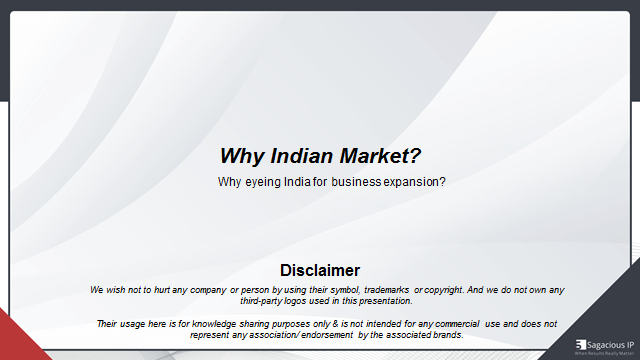
Rajat Gulati Speaking – Thank you, Tanmay. I will be taking up the first most important question of this session, that is, why the Indian market? Why eying the Indian market for business expansion can be an excellent decision. Well, we have tried to look at it from various angles and gathered some interesting facts for you, that you might be interested in knowing.
Before that, let me share the disclaimer with you. We wish not to hurt any company or person by using their symbol, trademark, or copyright. And we do not own any third-party logos used in this presentation. Their usage here is for knowledge-sharing purposes only and is not intended for any commercial use and does not represent any association or endorsement by the associated brands. Other than this disclaimer, let me tell you that I’m going to be a little fast with lots of data and interesting information to set the context for this webinar in the next 10 to 12 minutes. So, sit back and relax.
Here we go. Let me first share the broad headers that I’m going to quickly touch base that will help you understand what’s going on in the market with some facts, recent developments, and rankings, then I’ll share benefits of patent filings in India, followed by trends and stats around patent filings and will quickly see who all are filing in Indian market.
Well, with this, this will help us go to the next important question which will be discussed by my colleague, Rohit. So let’s not wait for that. Well, on this slide, you can see India has positioned itself as one of the top destinations for ease of doing business. According to the World Bank’s ease of doing business ranking, India has jumped 14 places. In 2019, it got a rank of sixty-three out of one hundred ninety countries.
India has improved its ranking in the Global Innovation Index in five places. India has recently grabbed the position of the second-largest smartphone market, leaving behind the United States. It’s now the third-largest pharmaceutical industry in the world by volume. It’s also third amongst the most attractive investment destinations for technology transactions in the world. India is now the third-largest start-up ecosystem in the world.
It has also swept away Germany to become the fourth largest automotive industry. Fourth, in the countries with most unicorns ranks higher than Germany, France, and South Korea, India is the world’s pre-eminent exporter for IT products and associated services.
Moving further, India is playing a leading role in launching satellites amongst SAARC nations and is among the top five nations in the field of space exploration worldwide generating revenue by offering its space facility for use to other countries. India has recently allowed private participation in the space sector, that’s going to be awesome as we may see private players and start-ups from India as well, similar to space-x or blue region and many more.
Engineering, R&D, and product development market in India is forecasted to grow at a CAGR of more than 20% to reach 45 billion US dollars by 2020. India’s R&D investment is forecasted to increase under Union Budget 1920, the Government of India announced the largest ever allocation to Science and technology. India is a preferred destination for FDI because of relaxed FDI regulations and other relevant policy reforms.
With various efforts around the Digital India initiative, India has the world’s second-highest number of Internet users, and it is increasing each day. India is also trying to simplify the taxation system to ease business and the most important fact that the Indian market is one of the largest consumer markets in the world.
Benefits: India as an IP Filing Destination – Patents
From here, let us move on to when you file a patent in India, what are quick benefits to you, other than getting a large consumer base.
Cost of filing Patent application in India
The cost of getting a patent in India is very low, as compared to many countries, because of lower government fees as well as the proficiency of IP agents and attorneys. The overall cost of getting a patent in India from filing till final decision lies within a range of 1500 to 2000 USD, which includes all the official fee.
Language of patent applications
An application for a patent can be filed either in Hindi or English at IPO, therefore, if you have an application in English, additional transmission efforts and charges are not at all required.
Reduction in various official fees
The Indian government has taken various initiatives to provide further impetus for increasing filings by reducing the fee for PCT application, MSMEs and start-ups and there is also a provision of the fee refund if excess fee gets paid during online filing process or if an applicant wishes to withdraw the patent application. There are various other monetary benefits for start-ups and small entities that can help India increase IP filings.
General Patent Trends
Now, let’s quickly dip-check the performance of IP filings in India and trust me, it’s going to be super interesting now. If you see the trends around patents from this bar chart, it’s evident that not only patent filing with blue bar is increasing but patent grants with green bars are also increasing each year with an exponential rise in examination shown with the red bars.
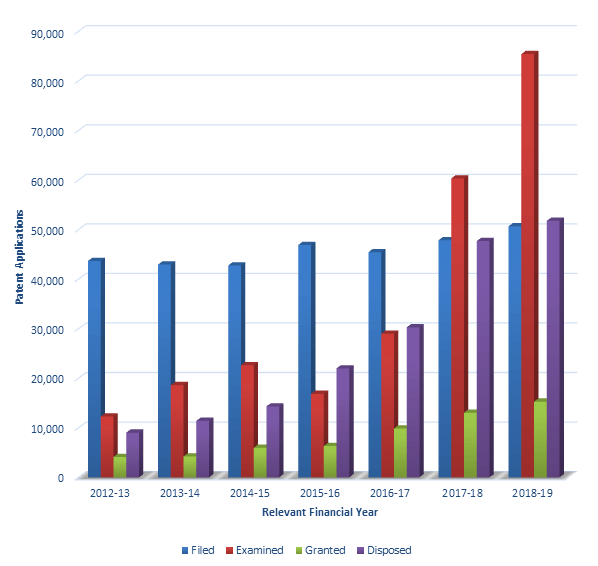
And if you see in this next bar chart, patent filings by Indian residents are increasing continuously. This means a patent originating from the Indian market is showing up a good growth rate year on year. Well, if you see in this next bar chart, patent filing by Indian residents is increasing continuously.
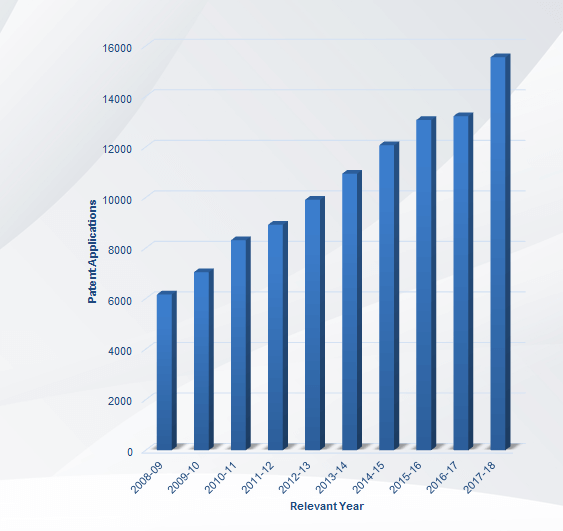
Moving on to the next chart, the next bar chart, comparing three routes to file a patent in India by non-residents, that is an ordinary or direct route with blue bar is increasing. Another route that is a Paris Convention route with red bars to filing a patent in India is also said to be increasing. The most preferred route that is the PCT route with green bars is also crossing the chart limits.
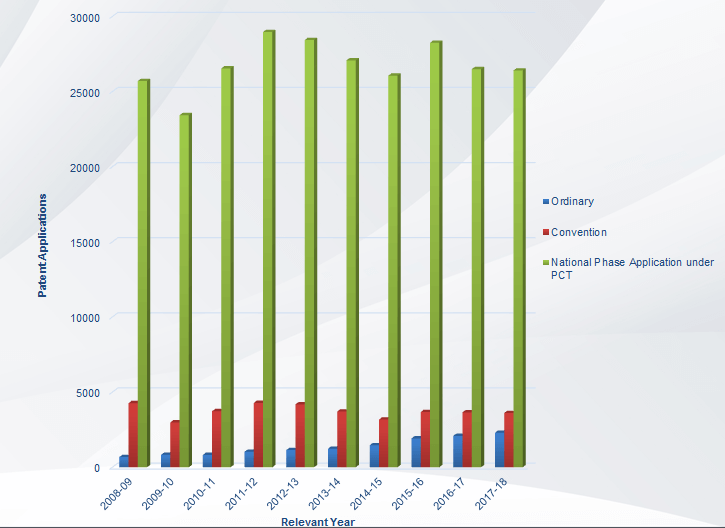
Now, let’s quickly check countries from where India is receiving maximum PCT filings. It is visible that one-third of patent filings are from the United States, followed by Japan, Germany, China, and many more.
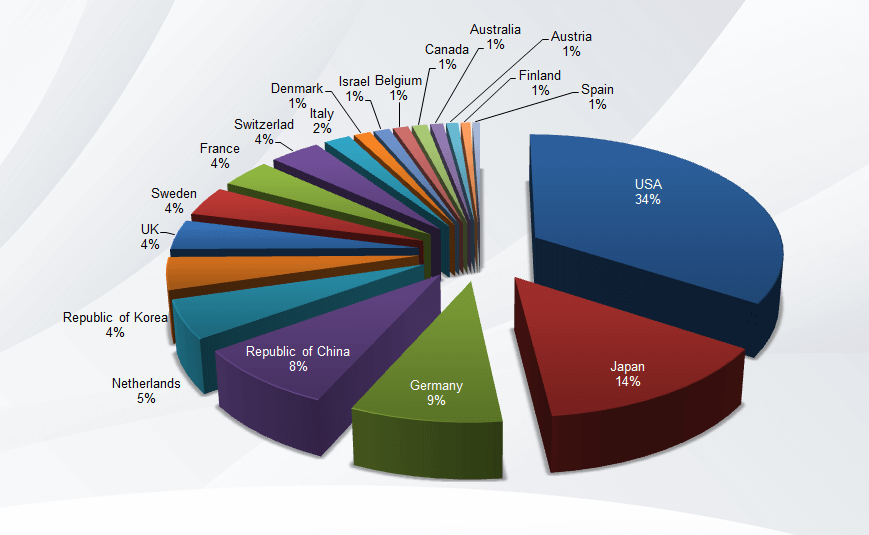
Further, let us see which all companies from these countries are filing the most applications in India. Qualcomm from the US, Honda from Japan, Philips from Europe, Huawei from China, and many more from other countries. With that, I think it’s very much visible that there is a long list of companies that we can discuss here. And you may be also interested in knowing top contributors from Indian markets, as well and these are TCS, BTL, Wipro, TVS motor, and many more contributing patent filings that are originating from India.
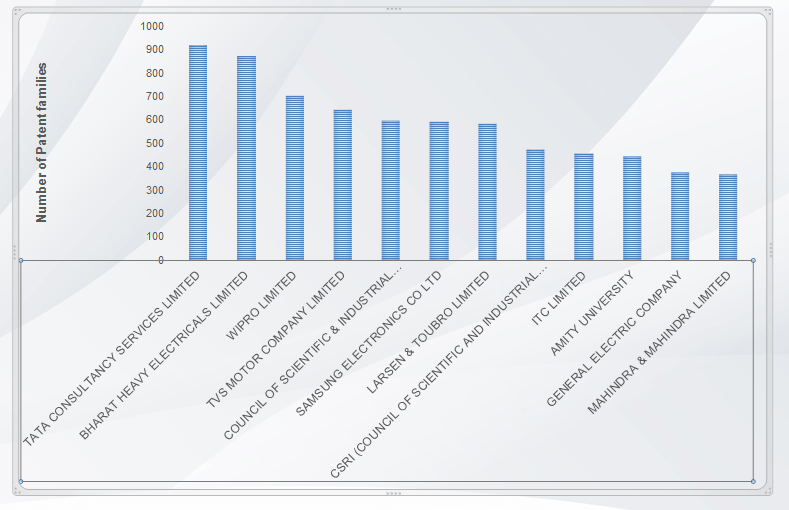
Till now, you must be excited to see these rising times from Indian market, and these trends are the facts and benefits must be making you think of what exactly is going on in Indian market around IP rights that is driving this interesting shift, exactly what got a change that is making Indian market so much interesting from IP filing and protection perspective. Well, we have created a detailed analysis of it for you.
I won’t be going in further detail in this webinar, as we need to come back to our topic. However, if you want a copy of the detailed report, you can contact us at [email protected] and we’ll surely get back to you. Now, let me pass the baton to my colleagues, Rohit and Tanmay. Rohit has conducted an excellent analysis for you, over to you Rohit and Tanmay, and thank you for your patience.
Tanmay Mittal : Thank you, Rajat for the insightful presentation, certainly the points you have captured are quite intriguing. India is now one of the geographies, which are a definite part of product strategy in most of the companies. And, that brings me to the point that searching patent information comprehensively and correctly, especially the Indian patent information becomes very important and the need of the hour.
We did a quick check on our end wherein we evaluated multiple databases, and we looked at various strategies to see how well can this information be searched. So, now, let’s hear from Rohit about this and let us listen to it from him on How to comprehensively search Indian patents information. Over to you, Rohit.
How to Comprehensively Search Patent Information
Rohit Joshi Speaking: Thank you, Tanmay. So, hi everyone, while performing our day to day projects, we identified at capturing in-depth information comprehensively is quite easy. But it needs some tips and tricks. In this part, we emphasize on these tips and see how searching Indian Patent information can be accurate and comprehensive.
To make this a bit interesting, we have conducted a study where we perform quick searches on various databases and would use this study to explain the best practices. In today’s webinar, we will go through three sections to elucidate the best practices to search Indian patents information.
- Comparative study on patent databases
- Accuracy of IPC classification
- Bibliographic information & Legal status for Indian patents.
Through the three sections, we will try to answer the following questions.
Which are the best databases for search Indian patents information comprehensively? Are IPC’s on Indian Patents correctly tact? Can we trust the IPC based searches for comprehensively covering Indian patents? Is assignee information reliable, means can we rely on the exact names of the assignee to search Indian patents on Indian patent websites? What is the best method to search to capture relevant Indian patent, visit IPC only, is it IPC plus keyword, is it keyword only, et cetera? And the last one is, is legal status detailed on various databases are updated and competent enough to be trusted?
To answer these questions we have chosen for well-known professional databases and compare their data with information available on the Indian Patent Office, official Search engine. These comparisons are done on the volumes of results obtained, the accuracy of Legal Status, and other bibliographic information for Indian patents and accuracy of IPC classification.
Once I finish my presentation then we will have a panel discussion on these questions with our external speakers. Please note that this study does not intend to endorse or defame any of the professional patent databases, that is the numbers and counts shown today are based on a search done on 8th June 2020.
Comparitive study on patent databases
So, let’s just start with Section one that is a comparative study on patent databases. Let’s see the volume of results obtained from various databases when we searched them based on classification, assignee, keywords.
Classification Search
The table on the screen summarizes the result count obtained when we executed three classification-based searches on 4 databases. We have used both broad and narrow classifications to get this. We will not be disclosing the names of these databases, and we hope that listeners will understand and appreciate this.
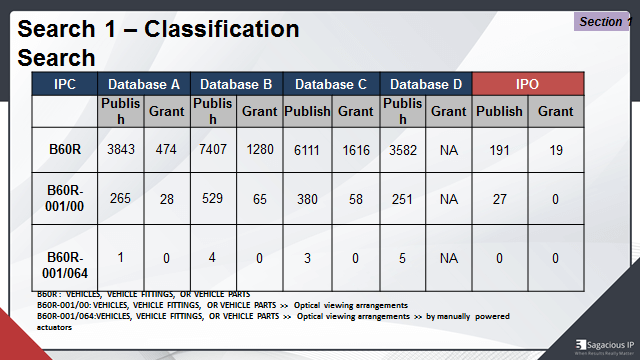
Also, we have observed that in broad classification, that is B60R, which is related to vehicles, vehicle fittings, or vehicle parts. Database B yields the maximum number of results followed by other databases. As you may see, the Indian patent website yields the least number of results that is 191 published patents out of 19 are granted. I am sure, most of us will be surprised by this count.
Similarly, when we have searched narrow classification, that is B60R 001/00, related to optical view arrangements in the vehicle. The trend is almost the same, the maximum number of results are identified by database B, which is 529 out of which 65 are granted. There also, the Indian patent website yields the least number of results, that is 27.
Then we move forward to further narrow classification, which is B60R-001/064, which is related to Optical View Arrangement in the vehicle by manually powered actuators. We observe that database D yields the maximum number of results that are 5 followed by database B, database C, and database A. However, the point to note here is that the Indian patent website yields zero results. This brings us to the important question: How is it possible for the professional patent databases to get a greater number of results compared to the Indian patent website?
We have observed that the Indian Patent Office has a receptive search engine for searching IPCs. For example, if you run IPC equal to B60, it will capture only those patents that have IPC classification as B 60. It will not capture patents with IPC as B60R. We also found that the use of truncations like + or * also delivers a conflicting number of results every time. And sometimes the search engine does not accept truncations at all.
Thus, we recommend using paid professional databases if your search strategy is based on classification. We advise you to use truncation there by searching classifications to get maximum results. There is one more reason for this discrepancy. I’ll be answering it later in Section three, in which I discuss the tagging of classifications on Indian patent. Also, please note that the numbers showed are mere count. And that these results are not evaluated manually to get the relevancy.
Assignee Search
Moving on to the second search based on the assignee. For this, we have considered a well-known assignee Denso. That table on the screen summarizes the result count obtained when we executed assignee-based searches on 4 databases. First, we use Denso assignee without any subsidiarity. The maximum number of results are yield by database B, that is, 843 out of which 201 are granted. This is followed by other databases D, C, and A.
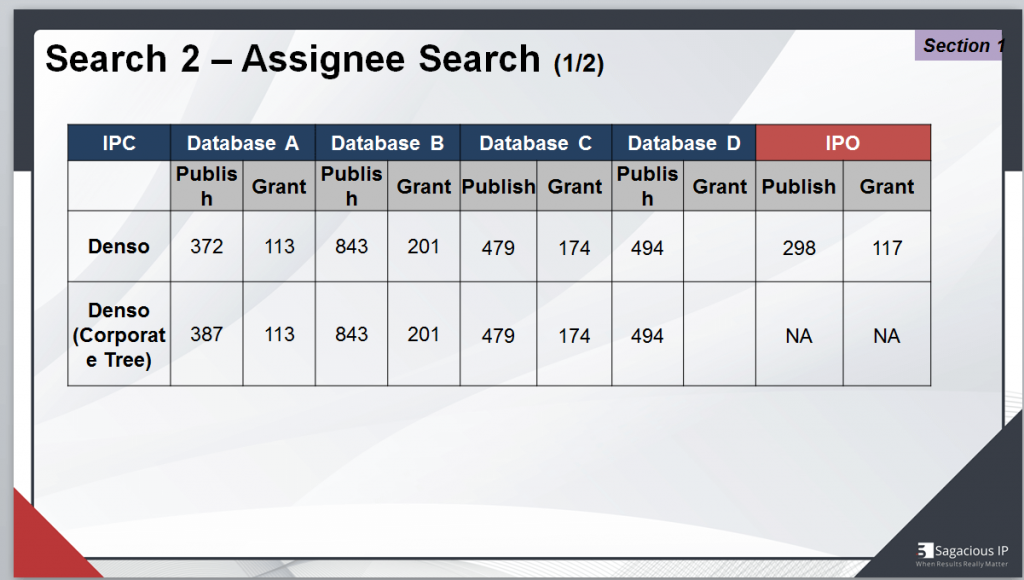
The Indian patent website yields 298 results out of which 117 are granted. Next, we conducted the assignee search by using the corporate tree functions of these databases. We observed that there is no change in the number of results of database B, database C, and database D, that is, they have yielded the same number of results. They have yielded without using corporate tree Function.
However, there is a change in the number of results yielded by database A. Earlier, the number of results with database A is 372 but with corporate tree function, the number of results increased to 387. But the number of granted patents remain the same. We would like to inform everyone here that the Indian Patent website does not have a corporate tree function.
Let us take an example of our observation on an Indian patent. So, this is a screenshot of the Indian patent website, you can see that assignee is not mentioned in the assignee section and this is precisely the reason why this patent is not captured in the assignee-based cell. We have also identified that many times assignments and reassignment information is not updated on the Indian patent website and that is also the reason for getting a fewer number of patents while using Assignees’ search on the Indian Patent Office website.
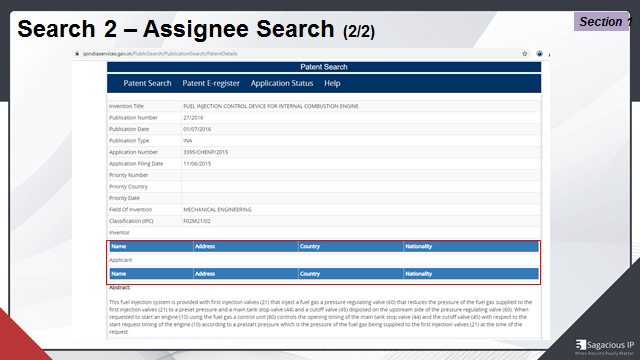
The important point to note here is that the professional patent databases generally capture assignee information through the family members of the Indian patent and this may be the reason for getting more results in the assignee search. We will know more about this in our panel discussion with our esteemed speakers.
To summarize, we recommend using paid professional databases. If your search strategy is based on assignees then we advise you to use the corporate tree function on these databases to get maximum results.
Keywords Search
Now, moving on to the next section, that is a Keyword-based search. So, in this part, we have conducted a keyword-based search on databases: A, B, C, and D, and compared it with a count from the Indian patent office website.
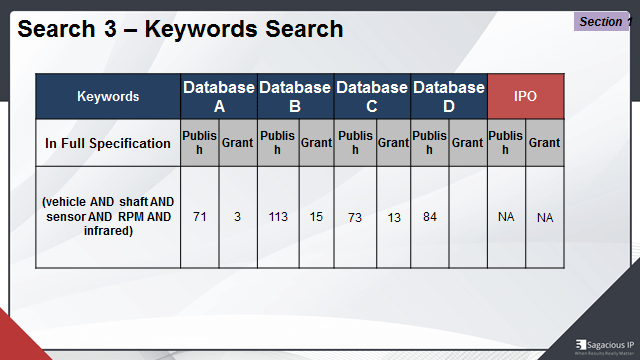
We have a run searching with keywords, vehicle and shaft, and sensor and RPM and infrared. You can see in the table, the maximum number of results are provided by database B, that is, 113 published patents out of which only 15 are granted. Indian Patent Office website identified a very high number of results. On a closer look, we identified that most of these are false positives and are not related to the domain in any way. That is the reason why we have marked NA in the results of the IPO.
Thus, we recommend using paid professional databases if your search strategy is based on keywords only and we advise you to use truncations while searching to get maximum results. To summarize the outcome, Section one indicates that nothing on the paid database is more comprehensive than searching on IPO alone.
Accuracy of IPC classification on Indian patent
Let us move to the next section, where we will be studying the differences seen in the accuracy of IPC classification on Indian patents. In the previous section, we saw a huge difference in the number of results identified by various databases, while performing a classification based search. While analyzing the results, we found that the tagging of classification is inaccurate in many cases. In this section, we will look at the accuracy of IPC classification for two types of patent, Indian patents without any family member(s), Indian patents with a foreign family member(s).
Indian Patents without any family member(s)
Let’s start with the first one, that is, tagging on classes on Indian patent without any family members. We have observed that most of the Indian patents are wrongly classified at the IPO and that is the proof, that is probably the biggest reason why they were not captured during the classification cell.
Let us see the first example of Indian patent IN1266. While analyzing the patent, we found that this patent is related to an outer rear-view mirror assembly with a fold and unfold mechanism. However, as per the Indian patent office website, it is tagged under class G01T, which is related to the measurement of nuclear or X-radiation. But as per Sagacious opinion, it should be tagged under B60R 1/06 which is related to rear-view mirror arrangement mounted on the vehicle exterior.
Let’s take another example, the Indian Patent IN1772/DEL/2009 is related to an external rear-view mirror assembly. The invention provides a mechanical external side rear-view mirror assembly with a novel mirror mechanism operable by lever mechanism with the help of pull-type control cables or altering the position of the mirror by the driver/co-driver for attaining the required rearwards field of vision which is related to measuring length, thickness, or similar linear dimensions like measuring angles, measuring areas, measuring irregularities of surfaces or contours.
So, let’s move to the third example. Here, we have checked the Indian patent IN1773. This patent is related to movement or adjustment of mirror which is controlled by the plurality of control cables which are connected with a control lever of the control lever sub-assembly. This patent is related to measuring length, thickness, or similar liner dimensions like measuring angles, measuring areas, measuring irregularities of surfaces or contours.
But as per the Sagacious opinion, it should be tagged under B60R 1/068 which is related to rear-view mirror arrangements mounted on vehicle exterior with remote control for adjusting position by manually powered actuators for adjusting the mirror relative to its housing using cables. I believe we can all agree that these three patents are tagged in the wrong classes as per the Indian Patent Office website. Therefore, if you conduct an IPC based search for Indian patents, you will not be able to find most of the patents as they are wrongly classified.
Interestingly, we found that professional patent databases have also classified these patents similar to how the Indian patent office website did, and we understand that this is because professional patent databases capture the information as marked by the IPO. Hence, the experience and skill of the searcher play a very important role here, even more than the choice of databases.
Indian Patents with Foreign family member(s)
Now, let’s move on to the next slide. In the second case, regarding Indian patent with foreign family member(s), we found that most of the patents are classified under broad classification, rather than a narrower and accurate one.
Let us take the first example. In the first example related to Indian patent, IN4542, this invention relates to an arrangement of button operated outward swiveling motion of the conventional rear-view mirror and returning to the original position after the completion of the swiveling which helps the driver to get a better and wider view of the vehicles surrounding its vehicle. As per the Indian Patent Office website, this patent is tagged under B60R1/00 which is related to optical view arrangement in the vehicle.
We found that the tagging is okay but quite broad, which can reduce the efficiency of the searcher. We believe that tagging of the patent in a narrower class, that is, B60R1/072 will be more useful. Let’s take another example, the Indian patent IN1532, this is related to a control mechanism of an adjustable rear-view mirror assembly.
The invention provides a side rear-view mirror assembly mounted outside the vehicle which is operable from a control mechanism mounted inside the vehicle with the help of two control cables. Again, as per the Indian Patent Office database, this patent is tagged under B60R 1/00 which is related to optical view arrangement in the vehicle.
Although the tagging is okay, it can be tagged in a narrower class, that is, B60R1/06, which is related to the rear-view mirror arrangements mounted on the vehicle exterior. Thus, by case 1 and 2, we can conclude that this tagging of Indian patent is incorrect, we should always go for an experienced and distilled searcher to perform searches on Indian Patent information.
In the next set of cases, we will evaluate the correctness of IPC in Indian patents having family members in other countries. So, let us see the Indian Patent IN2745. This patent is related to an exterior rear-view mirror about the field of motor vehicle accessories. This patent has family members in Brazil, Mexico, China, Russia, EPO, WIPO.
We found that the Indian Patent is tagged under G01L class which is related to measuring force, stress, torque, work, mechanical power, mechanical efficiency or fluid pressure whereas each family member is tagged under B60R1/06 which is related to rear-view mirror arrangements mounted on a vehicle exterior and as per Sagacious opinion, the Indian patent should also be tagged under B60R1/06.
Another important insight here is that this patent family is tagged under many other classifications by professional patent databases, as you may see in the table. Thus, identification of this patent or any of its family members during the search is more probable. Similarly, if we see the Indian patent IN2201, the present abstract relates to a patent of invention for an interior rear-view mirror system about the field of motor vehicle accessories. This patent has a family member in Brazil, China, Russia, Mexico, EPO, and WIPO.
From this table, it can be seen that the patent is tagged under G01N, which is related to investigating or analyzing materials by determining their chemical or physical property. Therein, the family member of Indian Patents is tagged under B60R-001/04, which is related to rear-view mirror arrangements mounted inside the vehicle. According to Sagacious opinion, this Indian patent should also be tagged under B60R-001/02. Further, as this can be seen from the table that this patent family is tagged under any other classification by the professional Patent database.
To summarize, we observed that foreign family members are more accurately classified as compared to Indian family members. Let us take one last detailed example of this. For patent IN3282, the general object of the invention illustrates a position of the inside mirror when the passenger looks towards the rear-view mirror reflected by the half-mirror. As per the Indian Patent website, this patent is tagged under classes B60R1/04 and B60R1/12.
All these classes are related to optical view arrangement or rear-view arrangement classes in the vehicle. On carefully analyzing its first family member, that is, Japanese member. By first family member, I mean the country where this invention is filed first. We observe that this Japanese member is tagged under 5 classes that are, B60R1/04, B60R1/00, B60R1/12, B60R11/02, H04N7/18. All these B60R classes are somewhere related to optical view arrangement or rearview arrangement in the vehicle except H04N which is related to the Closed-circuit television system i.e, the system in which signal is not broadcast.
I hope with this, our listeners will understand that Indian patents are not classified under all the classes where it should be tagged. In these scenarios, to search Indian patent information on a professional patent data basis makes more sense as they provide a more holistic view of our classifications tagged by various Patent offices where the family members are filed. Thus, for a robust strategy, one must search on a combination of one or more patent databases to arrive at more comprehensive results.
Differences in Legal Status and other Bibliographic Information
Here, we will be studying the differences seen in legal status and other bibliographic information for the Indian Patent website. So, in this section, we have created 4 cases and checked them on various databases under the scope of this study. Those cases are based on all four types of legal statuses- Alive & Granted, Alive & Pending, Dead & Expired, and Dead & Lapsed.
On all these slides on this section, you can see two parts on the slide, the left part of the slide will show the result obtained from an Indian Patent office website and the part on the right side will indicate the legal status shown by databases A, B, C and D.
Case 1 – Alive and Granted
Let’s take case one, that is, patent IN264187 titled as Fuel supply device, we observed that the legal information and other bibliographic information displayed on Indian Patent Office website, database A and database C is granted, database B and database D have shown the legal status as alive and active. So, we can conclude that the legal status for alive and granted patents is observed accurately in this case on all the databases.
Case 2 – Alive and Pending
Let’s move to the next case, so here we have taken the example of application IN9118, titled a Vehicle air-purification device. We observed that the legal status displayed by the Indian patent office website and database A is pending whereas database B is alive, the database D displayed it as active while database C displayed it as Active- applied, application awaiting examination. The important take away here is that database B displayed the status as Alive irrespective of whether the patent is granted or active. Now, we can conclude that legal status for alive and pending applications may have this discrepancy on different databases.
Case 3 – Dead and Lapsed
Let’s move to the next case, i.e, dead and lapsed Application IN8876, titled as Device and method for monitoring moving entity. We observe that the legal status for this patent on the Indian Patent Office website is withdrawn and on database C also it is displayed as withdrawn. However, in the database, it is displayed as pending and in database D it is displayed as active while in database B, it is displayed as intermediate.
Case 4 – Dead and Expired
Another example in this category is, IN1914 titled Brushless motors and fluid pump having the same. In this case, the Indian Patent Office website displayed the legal status as Application Abandoned and database C also displayed the same information as Inactive- Rejected / Refused / Suspended; Application abandoned U/S. The database D displayed the status as active while database B displayed the status as Dead, database A displayed the status as Lapsed; Pending application likely abandoned. I think with these examples, we can conclude that legal status for dead and lapsed patent applications may have discrepancies on different databases.
Let’s move on to the next case, i.e, Dead, and Expired. So, here we have taken the patent IN194525, titled as A switch mounted structure in which a plurality of switches is mounted. We observe that the legal status of this patent in the Indian Patent Office website is Renewal Discontinued. The legal status of these patents on database A is displayed as Expired, in database C, it is displayed as Inactive-Expired; Term Expired and in database D, it is displayed as Inactive.
It is to be noted that while IPO may not change the legal status of an application that may have completed its full-term or renewal fees has not been paid. Some of the paid databases do a date-based calculation to estimate if the patent has expired. Thus, we recommend referring IPO for getting accurate legal status information whenever you are working on critical FTOs or product-based searches.
A trick for all our listeners, there is another database provided by the IPO that indexes expired patents only. We’ll take a look at it in the next slide. So, please use the link mentioned here to cross verify the expired patents I hope the cases that I presented have raised a lot of questions. So, let me request Tanmay to take-over and start the panel discussion and question-answer round. Thank you.
Panel Discussion
Tanmay Mittal : Great points Rohit. And I think we can agree that for comprehensive search, one needs multiple strategies, multiple tools, and multiple databases. So, I’m sure we’re all now waiting for the panel discussion, as you mentioned. We may hear and learn from the experiences of our esteemed speakers and get an insight into some of the tips and tricks that they may have for the tools that we use.
So, before that, let me first ask for the initial remarks from our speakers on, what in their opinion is the best way to search Indian patents, only IPO or only databases or the combination of them, IPCs or IPC keywords? What in their opinion and experience is the most comprehensive strategies? So, over to you Manish, Ginish and Kavita.
Best way to search Indian Patents
Kavita Poddar : Yes, so as far as you see the various results from the various database, and it’s ultimately the analyst decision to make-out the things. Even if you’re getting more results that don’t mean that the data is more relevant. You need to reach it manually many times. So, being a database provider we always suggest doing the broader search.
In our platform, we have a family platform, so we suggest our customers broaden and then narrow down. So, always use the combination of classification and the keyword. If you see, your team has already shown you how classification has given mentioned by the Indian patent examiner there are a lot of loopholes.
So, we need to take those things, if you’re not searching by keyword, and only searching by IPC, there’s a very high chance you’re going to loose the relevant results. So, you should use all these tips and tricks to get more relevant result sets.
Tanmay Mittal: Very well said, let’s hear from Ginish. Ginish, what is your opinion?
Dr. Ginish George : Yes, Just to follow Kavita’s words. So, I’ll start with the keywords plus classification system. What we probate supplementary classification system in our database. So, for example, we provide concepts, technologies, and sub-technologies. These are like our AI engine, knock takes over from each document addition to classifications. So, from some point of view, they can be a frame in with keywords, classification codes like CPC or IPC, plus supplementary classification that we provide. A combination of all this will get us results set. So, I suggest users to use a supplementary classification system.
Tanmay – Great, great points Ginish. Manish, would you like to add something here.
Manish Sinha – I would just like to add that, going to the choice of whether searching an IP or paid database, as it is part obvious that you should use a commercial database and at PatSeer we put a lot of effort in curating the Indian content but as per the style of searching is concerned, I think you should begin with keywords because as Rohit pointed out, the classification can be a little bit deceiving.
The best way is, to begin with, keyword and if your result count is higher then, you can start narrowing by the process but that would be probably the way to be searching Indian content. And, of course, you can use styles, like, family-based searching, so that you can leverage the classification of the counterparts in other jurisdictions. So that’s actually what I wanted to say, and how you would like to search Indian Patents.
Tanmay Mittal – Have spoken like a veteran Manish. So, my next request is for you only. So, would you like to tell us if IPCs on Indian patents are correctly tagged at IPO? What have you observed? And what are your opinion on this?
What is the approach of professional databases while tagging patents? We would like to know from you.
If IPCs on Indian Patents are correctly tagged of not?
Manish Sinha – OK, so actually Rohit has given such a comprehensive analysis of the quality of IPC. I do have some data to share from my team. I think before 2016, we noticed that most of the classes were tended to be very broad. When we had done an internal study, before 2016, there was a broad level of classes being assigned.
However, since 2016 onwards, we see a considerable improvement in the quality of classes. Yes, there are still mistake as Rohit has pointed and some of those records are before 2016, but, we believe that it has considerably improved after 2016. And when it comes to your second question, about what methods we take. So at PetSeer, we have a dedicated Indian Patent data Pipeline team.
We have more than 500+ Indian users, so we give very high importance to the Indian patent content. A lot of them are law firms and they need the details very accurate and so we have been applying a combination of automated and manual clean-up procedures. Now, it is true that our job is to publish whatever is published by the Patent Office but there are cases where we standardized IPCs.
So, if there’s an extra zero based on the way we are publishing IPCs of any other jurisdiction, we standardize it, so that our searchers have a seamless experience across all the jurisdictions. But if the IPC class does not match any of the classes in the index, or the IPC index, in that particular thing get flagged and that’s where there is a manual review done.
When it comes to, searching for IPCs on PatSeer, I think that one needs to understand that the search syntax is important because you need to be sure whether you’re searching the classification sub-tree instead of just that particular class level. And of course, you can leverage the family-based as I mentioned previously also, you can leverage the family-based technique to leverage the classes of the family.
So, some of the methods that you can leverage, whereas let’s say if it’s a PCT entry, the classes of the PCT would get matched and they’re usually more accurate. So, these are some of the techniques that we do. However, we do not and it is just not possible for us to give IPC class of our own based on the content of the record and that is not something that we do.
Tanmay Mittal – OK, OK, so that’s a fair point. So, let us now hear from Ginish if we can trust the IPC based search for comprehensively covering Indian patents, what in his opinion would be the best practice in this regard.
If IPC based Search reliable for comprehensively covering Indian Patents?
Dr. Ginish George – So, we’ve heard from Rohit that IPCs are tagged very wrongly for Indian documents. Even from my personal experience, I got to see that for pharmaceutical molecules, IPO published IPCs in H-series. So, to follow IPO blindly for search or IPC search, you end up with lots of general searches.
So, earlier I mentioned the usage of searching for a great classification system that will support a user to make sure that they are getting results. For example, Rohit’s case again, for rear-view mirror system. If somebody is searching for a keyword plus IPC then they do not get the general result but supplementary classification system such as contents, technologies, sub-technologies which we derive using NHP+AAG which makes sure that IP knows the technology so we note down as already mentioned in the text as a part of the classification system. So, this will supplement a user’s query and they will get the Indian research.
Tanmay Mittal – Well said, well said. So, over to you, Kavita. Is assignee information against patents on the IPO reliable and what is the approach of professional databases while tagging patents based on assignee information?
Kavita Poddar – Sometimes, yes, but sometimes it comes when the name of the applicant is having a specific character, like a Spanish character. This causes wrong data publication sometime, so we need to cross-check. Being the database provider we have various data points for assignees: like assignee history, reassignment, patent company, owner company.
So, we check first in that data point we check with our corporate tree, we’ve our database provider for the corporate tree facts. They are very rich in European and US Companies database, corporate database. So, we try to check those points as well but I can say there is a gap between countries always because there’s different languages, different characters so what we do, we also take the clients’ feedback and normalize it further into finding different answers there.
We also have a dictionary. We maintain our dictionary for different countries, like Russia. If you see Universities as assignee, they don’t have their corporate tree. So, we need to manually check into the website, and other things to add in our database.
So, in Questel itself, we have 6 to 8 people, fully for the data curation. Thus, whenever we receive the data, for check and multiple checkpoints and we tick and finally when nothing matches, we manually check and enter into the database. So that’s what we do.
If I conclude here, as Manish has also mentioned there after 2016, there is a lot of improvement in Indian database, you might be knowing of the digitization project, it went to the HCL in 2011-12 then data operators, then after 2016, most of the applications are coming online, and they have the online data. So we’re getting much more data. In that way, on the previous data, we need to work a lot and we have worked on that in the current data, or whatever the new publications, it’s easy for us nowadays.
Tanmay Mittal – OK, fair point. So, that brings me to the next question, which is probably the most important question, and everybody’s waiting for that. So, is legal status detail on various databases updated and comprehensive? Please tell us your database strategy for updating this information. We can start with Ginish, then we can go with Manish and then Kavita.
Is legal status detail on various databases updated and comprehensive?
Dr. Ginish George – Ya, so Tanmay, we are getting legal status data from multiple vendors. So, in certain periods we are getting it an update. So, certain things apart from this legal status are active or it’s status, and more than we’ve form 27 details, whether the patent is in working position in India or not.
Plus, we started collecting data related to the stack whether the firm is in a new startup position or not. So, we are supplementing more and more details about the legal status field. So, make sure that legal status data is much reached.
Tanmay – OK, Manish.
Manish Sinha – So, in PetSeer, we not just merge the legal status that you receive periodically from the patent office into one of our standardized legal statuses, but we also capture the data as it is available on the register. We have a team like I mentioned, that periodically update legal status, register legal status based on the information that we receive from the IPO and so you can also leverage that register legal status which is more descriptive than the standardized legal status. And that this is very helpful for, especially those in the legal profession advising their clients.
So, that is one thing that we do additional and this is also for some other countries but wherever possible, we do that. That’s pretty much what we do on the legal status to keep it as accurate. The periodicity of updates from the Indian Patent Office varies. And so that is why even our updates fluctuate based on what update we have received from there. But we try to keep it as close as possible to the Indian patent
Tanmay – Great. Good point. Kavita?
Kavita Poddar – Ya, same here. But, as you know, the Indian patent often, they don’t sell the data. So, we have to rely on the third vendor in our team to accurate them manually. So, earlier our options were like, we generally used to get the legal status from the EPO, and then we walked out from EPO. But we’re also working on that and we have the Indian vendor who is providing the data.
On that basis we accurate, we manually accurate the data. But if you see the status most of the time, 99% time, it matches the general status orbit. The legal status, there may be a little bit here and there, but we also collect more accurate data.
Tanmay Mittal – And we had a question from our audience as well about how the patent databases fetch data from IPO. I think Kavita that you have almost answered it. And, just to reiterate, we have third party vendors that the Indian Patent Office doesn’t sell. So, we have third party vendors through which all the other databases collaborate and then they get the data.
How Patent databases fetch data from IPO?
We have another question from the audience and probably Ginish would like to answer that. So, the question is, why is there a difference in the number of counts or why is there a difference in the count of patents being identified by various databases, even if the same strategy was used? Well, why is there a difference in this count?
Dr. Ginish George – There could be multiple reasons behind it, that is in each data they have indexing methods or other search engines they are using an indexing search engine, even stabling of keywords or technical things related. An experienced analyst can get the right set of parameters and get the right set of results.
Tanmay Mittal – OK, that’s a fair point. And in our experience, I mean, me being associated with the IP industry for over nine years now and most of that time was in project execution. I’ve also found that relying on just one database there will always be a discrepancy, or there will always be a difference in the count. So, just as a tip, relying on one particular database to do a comprehensive search would not be a good way to do it.
Instead, I would recommend all our listeners to try and subscribe to multiple databases or probably hire a professional search provider, anyone they want. But that will allow them to get searches done using multiple databases at one time and be more comprehensive in their results or the findings. With that, I think we do not have any more questions so far, and considering the time, I would like to thank everybody.
This has been a wonderful session and I’m sure our listeners have great takeaways from this session. And we’ll be able to use several of these pointers while searching for patent information specifically to search Indian patents. We have been able to cover most of the questions that we had. We had a few queries related to getting the presentations and the recording for this session.
So for that, I would request our listeners to drop us an e-mail at [email protected] and we will send you a copy of the same. Also, regarding the comprehensive guide that Rajat spoke about earlier in his session. In case you want a copy of that, you’ll have to e-mail again at [email protected].
As I already mentioned, Sagacious is going to conduct three more webinars in the same context. So, researchers understand all the best practices that are there and search or to perform comprehensive searches. The next webinar will be on how to search non-English patent literature comprehensively. We will cover Chinese, Japanese, and Korean patents there as well, which tends to be an important aspect. And also, in the webinar after that, we’ll talk about top tips to tackle assignee name variations, subsidiaries and assignment changes in any patent search as Kavita added a little bit about it or how it is being done. We’ll talk in detail about it in the next session.
Tanmay Mittal – OK, again, I want to extend a big thank you to all our listeners who helped us start on time and stayed with us for the extra five minutes. We highly appreciate that and thank you very much. Have a great evening ahead.



